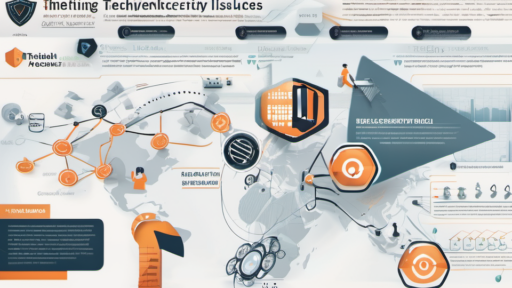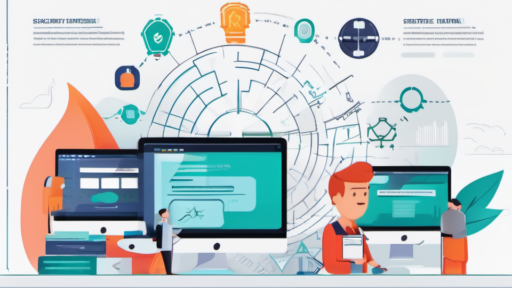Prepare for the Future of Cybersecurity
You’ve probably heard about the latest cybersecurity breaches, right? Those stories about sensitive data breaches, malware attacks, and identity theft can make you feel vulnerable. But here’s the thing: the future of cybersecurity isn’t just about reacting to these threats. It’s about building a proactive, comprehensive strategy that safeguards your organization and puts you ahead of the curve.
We’re going to delve into a world of advanced cybersecurity tactics that empower you to become a cybersecurity master. We’re talking about:
- AI-powered security: Think predictive threat analysis, real-time anomaly detection, and automated incident response. These are the building blocks of future-proof protection.
- Cloud-based security: The modern world runs on the cloud. This means your security must too! We’ll dive into cloud security architecture, cloud access security broker (CASB), and cloud native security solutions to secure your critical data.
- Zero Trust Security: Forget outdated “perimeter-based” security. Zero Trust forces you to rethink everything! Verify everything, enforce least privilege access, and securely manage your entire attack surface to build an impenetrable defense.
Are you ready to step into this next generation of security and turn the tables on cybercriminals? Let’s dive in!
Harness the Power of AI for Proactive Protection
Gone are the days of reactive cybersecurity. In today’s evolving landscape, AI-powered security is your secret weapon.
Predictive Threat Analysis: Forecasting Attacks Before They Happen
Imagine having the ability to predict future cybersecurity threats before they even emerge. Sounds like a sci-fi movie? It’s not! With AI-powered security, you can actually do this.
Here’s how it works:
- Analyze vast amounts of data: AI tools analyze historical attack patterns, security logs, vulnerability reports, and even external threat intelligence sources.
- Identify patterns and trends: Based on this data, AI can identify potential attack vectors and vulnerabilities.
- Predict potential attacks: AI algorithms can generate predictive threat assessments that highlight vulnerabilities and attack methods that could emerge in the future.
Real-Time Anomaly Detection: Catching Cyber Threats in the Act
AI’s strength lies in its ability to analyze massive amounts of data in real time. This power lets you detect even the most subtle anomalies within your network traffic, user behavior, and system activity.
Here’s how this works:
- Continuous monitoring: AI constantly analyzes your system data, including network traffic, user activity, and file changes.
- Outlier identification: AI algorithms are trained to recognize normal patterns within your organization’s activity. Any deviation from these norms raises red flags, alerting your security team.
- Faster threat detection: This process allows you to identify malicious activities much faster than traditional methods, ultimately leading to a quicker response time and potentially preventing widespread damage.
Automated Incident Response: Rapidly and Efficiently Containing Attacks
With AI’s power comes the ability to automate incident response, drastically reducing the time it takes to contain cyber threats and minimizing damage.
This automated response includes:
- Rapid Threat Detection: The system swiftly detects the threat and initiates an appropriate response based on the established playbook.
- Automated Containment Actions: These can range from isolating the affected system, quarantining infected files, or automatically applying necessary security patches.
- Enhanced Security Post-Incident: Once the immediate threat is contained, the system analyzes the attack for root cause, improves security posture for the affected areas, and enhances the overall cybersecurity posture to prevent similar future attacks.
Benefits of AI-Powered Security:
- Enhanced Threat Detection: Uncovering hidden patterns and subtle anomalies that might escape human eyes.
- Reduced False Positives: Minimizing security alerts that aren’t actual threats, enabling your team to focus on the real risks.
- Improved Security Efficiency: Automating tasks, enabling security teams to dedicate their efforts to more strategic initiatives.
Embrace the Cloud: Securing Your Digital World
The cloud is no longer just a buzzword; it’s the backbone of the modern digital world. Your security strategies must evolve to encompass the cloud.
Cloud Security Architecture: Building a Secure Foundation in the Cloud
Moving your critical data and applications to the cloud demands a proactive, holistic approach to security. Your cloud security architecture should incorporate:
- Identity and Access Management: Tightly control access to cloud resources and sensitive data based on user roles, policies, and multi-factor authentication.
- Data Encryption: Encrypt data both at rest and in transit to prevent unauthorized access, even if cloud systems are compromised.
- Network Security: Employ firewalls, intrusion detection and prevention systems (IDS/IPS), and advanced network segmentation to protect cloud networks.
- Vulnerability Management: Continuously scan your cloud environment for vulnerabilities and proactively patch them to prevent exploitation.
Cloud Access Security Broker (CASB): Securing Access to Cloud Apps
Cloud applications offer incredible convenience, but they can also present security challenges. This is where CASBs come into play.
- Visibility and Control: CASBs provide visibility into your users’ cloud app usage and activity, enabling you to enforce security policies across various cloud services.
- Data Protection: They can help you manage sensitive data in cloud applications by ensuring that data is encrypted, enforcing access controls, and providing data loss prevention (DLP) mechanisms.
- Compliance Monitoring: CASBs ensure that your cloud applications comply with relevant regulations, such as HIPAA for healthcare or GDPR for personal data protection.
Cloud Native Security: Integrating Security Throughout Your Cloud Journey
Cloud native security means integrating security considerations directly into the development and deployment processes within your cloud environment.
- Container Security: Secure containers through vulnerability scanning, image signing, and access control mechanisms to prevent attacks targeting your containerized applications.
- Serverless Security: Secure serverless applications by employing access control, IAM (identity and access management), encryption, and auditing to protect serverless functions.
- Continuous Integration/Continuous Deployment (CI/CD) Security: Integrate security into the entire development lifecycle to ensure that security is embedded from the beginning.
Benefits of Cloud-Based Security:
- Scalability and Flexibility: Security solutions can scale dynamically alongside your growing cloud infrastructure.
- Cost Efficiency: Pay-as-you-go models can save you money compared to traditional on-premise security solutions.
- Improved Security Posture: Access to specialized cloud security expertise and resources provided by leading cloud providers.
Zero Trust Security: Rethinking Your Security Mindset
Traditional perimeter-based security is failing. Attackers bypass firewalls and exploit vulnerabilities beyond the traditional network edge. This is where Zero Trust security shines.
Never Trust, Always Verify: The Cornerstone of Zero Trust
Zero Trust security fundamentally changes how you think about security. It rejects the idea of granting automatic trust based on network location. Instead, every access request is meticulously scrutinized and validated.
- Continuous Authentication: Verify user identities and device health at every access point and during every session.
- Least Privilege Access: Grant users only the necessary permissions for their job functions.
- Segmentation and Isolation: Divide your network into smaller segments, isolating critical data and applications.
- Real-Time Monitoring and Analytics: Continuously monitor user activity and system behavior for suspicious activity and anomalous patterns.
Securing Your Entire Attack Surface: A Holistic Approach
Zero Trust requires a comprehensive security strategy that encompasses every facet of your organization’s digital presence. This includes:
- User and Device Authentication: Implementing strong authentication methods like multi-factor authentication (MFA) and biometrics.
- Data Security: Employing data encryption at rest and in transit, enforcing data access control policies, and implementing data loss prevention measures.
- Network Security: Utilizing firewalls, intrusion detection/prevention systems (IDS/IPS), and network segmentation to control traffic flow.
- Application Security: Implementing security measures within applications, such as input validation, secure coding practices, and runtime application self-protection (RASP).
- Endpoint Security: Securing all devices within your organization’s network with anti-malware, vulnerability scanners, and endpoint detection and response (EDR) technologies.
Benefits of Zero Trust Security:
- Stronger Security Posture: Eliminating implicit trust and meticulously verifying every access request.
- Reduced Attack Surface: Limiting the impact of successful attacks by reducing the potential for lateral movement within the network.
- Improved Compliance: Enabling easier compliance with data security regulations by enforcing access controls and monitoring user activity.
Key Takeaways:
- AI-powered security: Use predictive threat analysis, real-time anomaly detection, and automated incident response to prevent and rapidly contain attacks.
- Cloud-based security: Build a strong cloud security architecture, leverage cloud access security brokers, and implement cloud native security strategies to safeguard your data.
- Zero Trust Security: Reject implicit trust, verify every access request, secure your entire attack surface, and continuously monitor and analyze your network.
The future of cybersecurity is one where you can’t just react to threats—you must be proactive and build a dynamic, intelligent security system. These strategies are more than just technical solutions; they are a mindset, a cultural shift. By embracing them, you can confidently face the future of cybersecurity, confident in your organization’s ability to protect its data and reputation.






